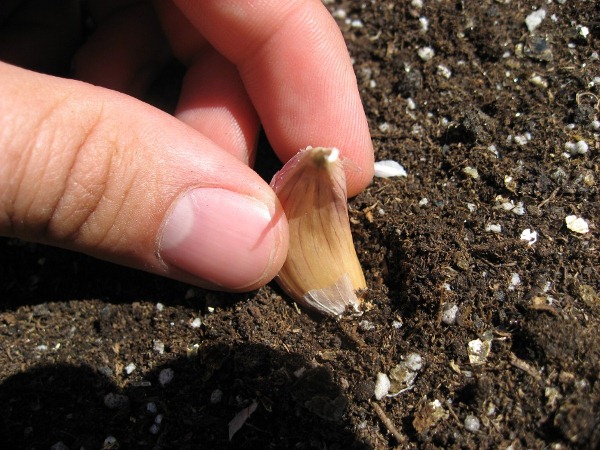Experienced gardeners have repeatedly surprised everyone with the results of growing root crops that are not typical for regions with a harsh climate. One of these is garlic. It is quite possible to cultivate on the site, if you follow simple rules on disembarkation and care. In this review we will talk about the features of planting spring garlic in the spring and growing it in Siberia.
Table of contents
Terms for planting summer garlic in Siberia
Garlic belongs to frost-resistant plants, it withstands severe winters under a thick layer of snow and is not afraid of frost. But in a snowless season planting material can freeze out. therefore in Siberia, the Urals and the Leningrad region give preference spring disembark.
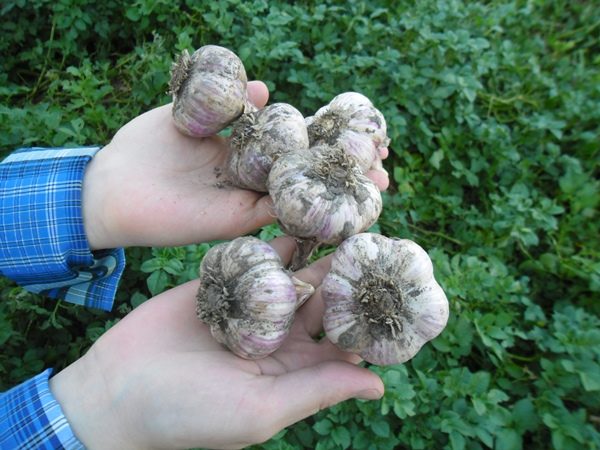
Winter varieties must be planted between 15 September to 5 October Sowing must be completed 3-5 weeks before the onset of frost, in order to have time to form the root system. It is important that the shoots do not have time to break through to the surface of the soil, otherwise the plant will die.
Spring disembarkation begins in late April - early May. The optimal temperature for the initial stage of the growing season is considered to be the range of positive values from 5 to 10 degrees. The duration of ripening and yield depends on the storage conditions of planting material.. Faster on the surface of the soil shoots are formed, formed from cloves that were stored in a cold way (at a temperature of 0 ° -3 °). However, the heads are formed in small sizes, and in hot and dry weather, single-teeth are often formed. The yield of this method is not different.Garlic stored in a warm way (at a temperature of 20 ° -25 °) ripens 25-40 days later. The heads of such plants form large ones with large teeth. To accelerate ripening, it is necessary to prepare the planting material for planting: soak, germinate and plant.
The benefits of spring planting spring garlic
In temperate climates, autumn planting in open ground has advantages over autumn. For growing crops in Siberia, spring varieties are more suitable which must be planted in the spring after the establishment of the daily positive temperature. This approach is due to the reduced risk of freezing of planting material due to severe frosts and the lack of a snow layer. In addition, plants are less demanding of the soil, you can get a good harvest on light and medium loamy soil types.
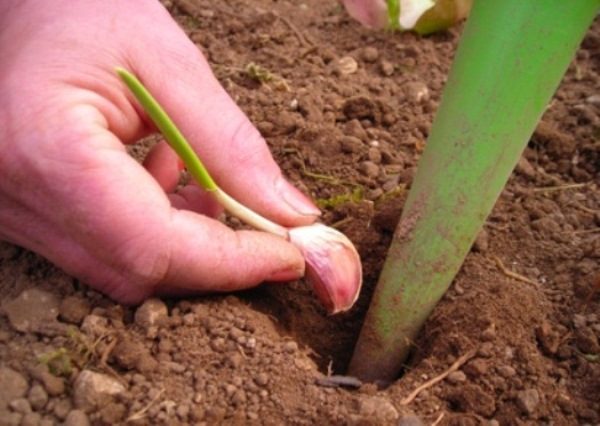
Undoubtedly The advantage of spring planting is the high resistance of summer garlic to bulbous plant diseases and pests.. Yes, and shoots are formed friendly with approximately the same development.Also excluded bald spots on the beds, resulting from the freezing of individual teeth.
Preparation of planting material: soaking and processing
The quality of garlic as onion depends in particular on the preparatory work, so planting material should be selected responsibly. When choosing garlic, you should pay attention to whether the head belongs to the winter or spring variety. How to distinguish them? Head winter to the touch elastic with a dense shell. In the middle there is a rod around which the cloves are located. The shell of the spring variety is thin, resembling parchment. The cloves are arranged in rows without a central rod. An exception is the variety Gulliver, which forms an arrow.
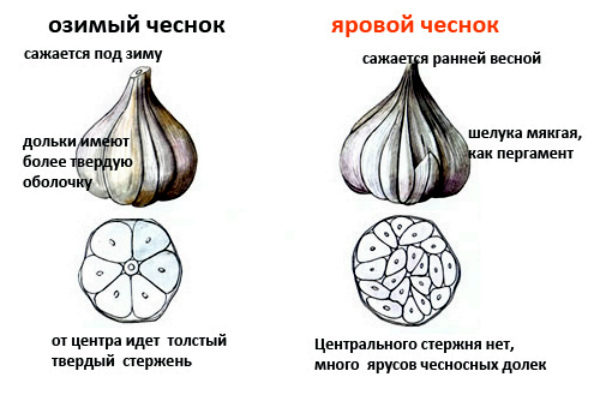
Preparation consists of the following steps:
- head separation on separate teeth;
- selection of whole and large, no signs of damage to the specimens;
- wrap cloves in a damp cloth for germination (for several days a lump can be sent to the refrigerator on the lower shelf);
- dunkin warm water for 10-12 hours;
- drying after soaking.
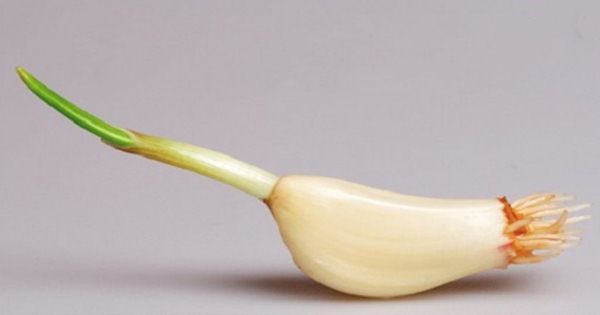
How to prepare the soil in spring and autumn
The soil before planting must be prepared. To do this, it is necessary to fertilize the site with humus and mineral substances in the fall (40 g. Of superphosphate, 20 g. Of potassium chloride per 1 m2). If there was no opportunity to carry out the autumn work, need for 1-2 weeks before landing land to dig enrich it with humus or compost, well loosen clods rake. A couple of days before disembarking, place under the beds should be treated with saline.
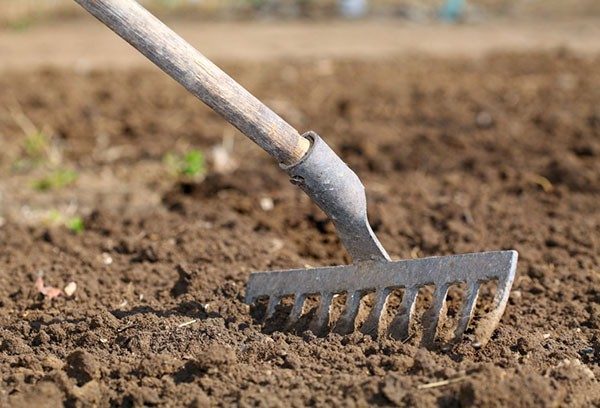
Experienced gardeners do not recommend planting garlic in the same place, you need to give a break of 3-4 years. It is better to choose areas in the garden where last season zucchini, cucumber, pumpkin were grown.
Proper landing in open ground
Culture planted according to the scheme:
- interval between rows - 20-25 cm;
- distance between teeth - 6-10 cm
It is not necessary to dig far the garlic, it is enough 3-5 cm. In the opposite case, the shoots may germinate slowly or not appear at all on the surface of the soil. The bottom of the tooth should be placed at the bottom of the hole, the root system will be formed from it. Before planting, the material germinated, so do not press it hard into the ground, so as not to damage the shoots.
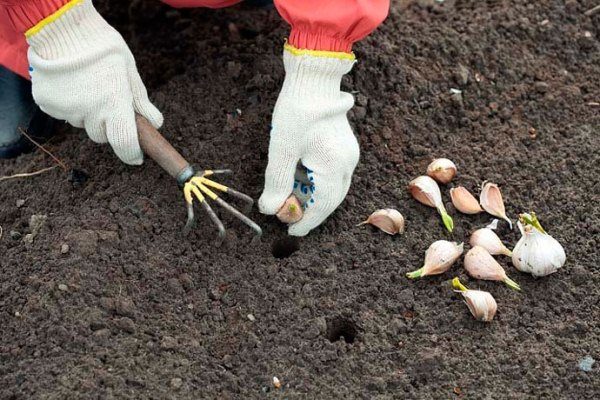
After deepening the teeth, you need to fill the bed with soil and introduce fertilizer. The most commonly used ammonium sulfate, which not only enriches the soil with nutrients, but also protects young shoots from pests.
Post-planting care and cultivation
Even an unpretentious plant needs proper care. It helps to increase the yield and get high-quality roots with a long shelf life. For this, first of all, it is necessary to adjust the watering. Moisture is a major factor in the growing process, however, its oversupply may cause the onion to rot. Therefore, it is necessary to carefully rely on the recommended rate of irrigation, taking into account the amount of precipitation, humidity, and soil type.
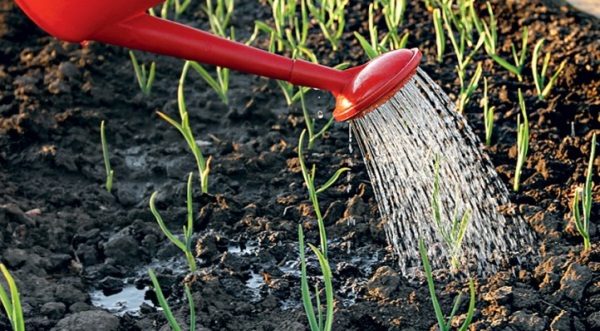
The average rate of water used for irrigation is 8-10 liters per 1 m2. 20-25 days before harvesting root crops, watering stops completely.
Fertilizers and bait are introduced twice during the growing season.. Their quantity depends on the fertility of the soil. Practically does not need enrichment chernozem. Other types of soil have less nutrients, so they need fertilizer.
The first bait is injected after germination. If ammonium sulfate was not used immediately after planting, then after sprouting, it is time to protect them from diseases and pests. In June, complex mineral fertilizers are used in quantity, according to information from the instructions. It is also allowed to use a mixture of urea and potassium chloride (the components are taken in equal proportions).
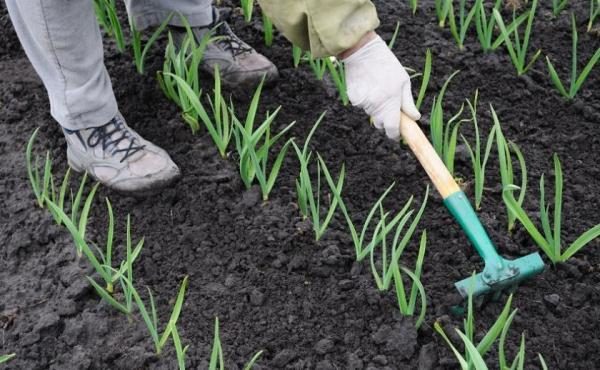
To enrich the soil with oxygen it is necessary to loosen. It is often combined with weeding, because weeds are a danger to culture. The abundance of shade and thickening of the beds become a place for the settlement of insect pests. Yes, and excess moisture can cause head rot. During the vegetation stage is held 2-4 loosening and weeding procedures. You can reduce labor costs by mulching the beds. Peat or sawdust is used for this purpose. They are covered with a tight bed, as a result of which weeds make their way to the surface not so intensively, and the soil does not dry out.
An advance plan of activities will ensure the timely care of garlic, which ensures the removal of a good harvest.
